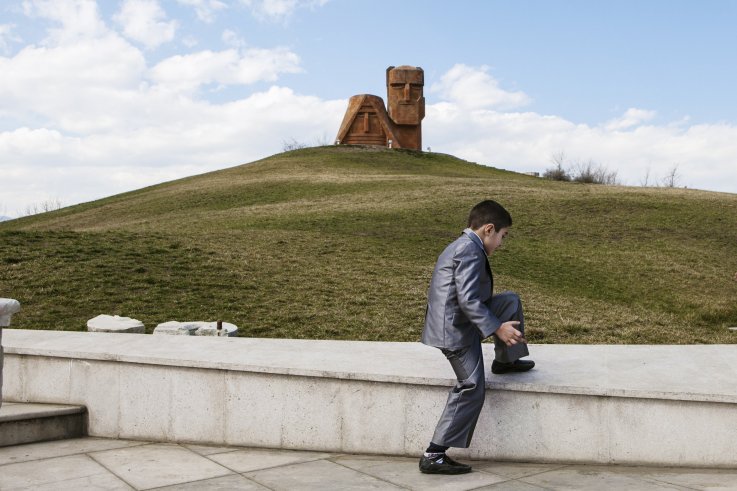Growing up Under Fragile Peace: The Youth in Nagorno-Karabakh, in Photos

Over 20 years ago, the guns were meant to fall silent in Nagorno-Karabakh, the forested heartland of the Caucasus mountains. After years of bloody conflict and the deaths of 30,000 people, Karabakh's ethnic Armenian majority and the state of Azerbaijan, which they were part of in name but not in aspiration, entered a cease-fire, also signed by Armenia.
The truce has since been shaken by violence many times. Nagorno-Karabakh's self-declared independence has not been recognized by a single state. Tens of thousands Azeris have been displaced from Karabakh and hundreds of thousands have fled the surrounding regions of Azerbaijan, used as a buffer zone. Karabakh's Armenian-speaking people, however, have remained. April 4 saw one of the most dramatic examples of how quickly life in Karabakh can turn very harsh. In a few days of clashes along the contact line, Azerbaijan boasted of "destroying" 170 opposing troops, while sources from the Armenian Karabakhi forces estimated they had killed 300 Azeri soldiers. In the heat of action, threats intensified, and the Azeri Ministry of Defense threatened to strike Karabakh where it hurt, in its capital of Stepanakert. Armenia's president, Serzh Sarkisian, countered with a warning of "full-scale war."
And as if the words had not been spoken, by Tuesday afternoon the game of brinkmanship was once again paused, and the uneasy cease-fire continued again. Each side reported collective casualties of 64 people, and life in Karabakh continued. The aspiring republic's people grow up with knowledge of the how contingent times of calm are. Many of Karabakh's residents are given frequent reminders of a war they are too young to recall. Yet despite the harsh and fickle realities of the nearby frontline, they continue to dream and find ways to have fun.

There are not many signs of nightlife in Karabakh for teens and 20-somethings even in the capital of Stepanakert, by far the most populous and developed settlement in the aspiring republic. To those looking for a night out, Stendhal Club is the only disco opened until late in the city. Others prefer to meet at home or in restaurants.
Parts of Stepanakert, which stands around 20 kilometers from the contact line with Azerbaijan, have been rebuilt since the war. "The situation and city is quite dark," Gianmarco Maraviglia, one of the two photographers behind our gallery says. "The frontline is very close and the people know it." Other towns around such as Shushi, where little to no rebuilding has happened, bear the scars of war even more heavily.
Lika Zaqaryan is a political science major at Stepanakert's Artsakh State University, where she is also prima ballerina in the ballet troupe. She knows opportunities lead abroad but she says she will always return to Karabakh.
"I want to go to another country to improve my education but when I do that I don't want to stay there," Zaqaryan says. "I want to come back and live here in Nagorno Karabakh. I hope it will be a peaceful Republic of Nagorno Karabakh or maybe a part of the Republic of Armenia."
She says everyone worries about their brothers, fathers or grandfathers in the military but hopes the "problems with Azerbaijan on the border" can be resolved.

Grigor Khagramanyan, 13, has his sights on traveling the world. "I'd like to go to Iran. I'd like to see their carpets," he says, looking on from his school window. "And Singapore, to see their many high buildings. Maybe South Africa will be good," he says. "I have one friend, his father is working in the army, he's a general. He wants to be like his father, I know." Grigor himself says he has heard a lot about the army from his friend. He says it is "interesting."
Knar Babayan, a photographer and journalist, is old enough to remember the violence of the late 1980s and so proud that she has had the chance to leave Karabakh and returned. "I studied here, then moved to Yerevan and I also had a chance to study in Georgia. I was also abroad to participate in workshops," she says. "Every time I come back my friends ask me 'Really you don't want to leave Karabakh?'"
"I found that I could not live more than 10 days away from home," she laughs. "One of my lecturers told me I am lucky because at my age I understand that I have a home."
Wealthy benefactors from the Armenian diaspora have helped finance a handful of venues in Karabakh to help better the lives of the young and their career prospects. A small new soccer field has been built in central Stepanakert, where children can play. For those whose minds are more tech-geared, Stepanakert has also opened the Tumo Center for Creative Technologies.
The center is modeled after projects in Armenia, and it allows children develop skills in art and computer science, with a well stocked inventory of digital resources. The center is open free of charge to any under-18s and its sister-centers in Armenia have already established three startups.
Gohar Aushar, an aspiring filmmaker at the Tumo center in Stepanakert, says she would like to hone her craft abroad, but her inspiration will "always be Karabakh and Stepanakert."
"I think a documentary would be a good idea," she says. "Our country has a lot of history and I think other countries should know about it. I would like to film a story about our historical memorials and shoot Tigranakert."
"I think there is no difference between Armenians and Karabakhis because we are one nation," she says.
Photos by Gianmarco Maraviglia and Karl Mancini.



